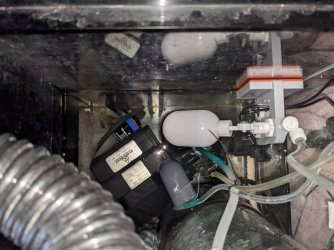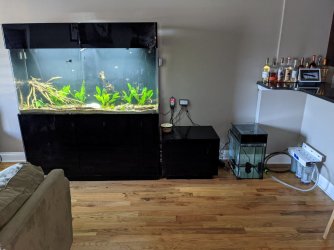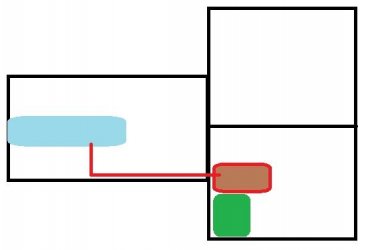Hello everyone,
so let me start by saying I am not completely new to the hobby, I had a Juwel Rio 180, like 5 years ago with malawi cichlids. Now I moved to my own house and I decided to go BIG this time (as much as space allows)
So the viewing tank will be 200x66x60 cm (approximately 80x25x23 inch) which should be around 750liter (200 gallons). I have somehow decided for freshwater, but I am not 100% convinced, I might go for saltwater if you convince me
I want a bare minimum in the living area, where the display tank will be, therefore my idea is to run the hoses (pipes) to basement (2m (6ft) vertical and 5m (15ft) horizontal), where I will easily do water changes (maybe automated), make any filtration I want and heat the water. In the display tank I might put some power head (wave maker) I assume it will be needed. Inside I plan to have a 3D background with some rocks and/or wood and thin layer of some sand. Minimum or no plants with a reason to minimize maintenance in the display tank. Aquaponics in basement is an option later.
Now that you know the basic idea, I have several questions or areas where I would need help. Stocking is not decided yet, I want to plan a system to handle anything I decide to put in over the following years (guppies, cichlids, discus, angels, axolotls, betta...)
so let me start by saying I am not completely new to the hobby, I had a Juwel Rio 180, like 5 years ago with malawi cichlids. Now I moved to my own house and I decided to go BIG this time (as much as space allows)
So the viewing tank will be 200x66x60 cm (approximately 80x25x23 inch) which should be around 750liter (200 gallons). I have somehow decided for freshwater, but I am not 100% convinced, I might go for saltwater if you convince me
I want a bare minimum in the living area, where the display tank will be, therefore my idea is to run the hoses (pipes) to basement (2m (6ft) vertical and 5m (15ft) horizontal), where I will easily do water changes (maybe automated), make any filtration I want and heat the water. In the display tank I might put some power head (wave maker) I assume it will be needed. Inside I plan to have a 3D background with some rocks and/or wood and thin layer of some sand. Minimum or no plants with a reason to minimize maintenance in the display tank. Aquaponics in basement is an option later.
Now that you know the basic idea, I have several questions or areas where I would need help. Stocking is not decided yet, I want to plan a system to handle anything I decide to put in over the following years (guppies, cichlids, discus, angels, axolotls, betta...)
- What filtration to choose? As mentioned above, the filtration will be done in basement. There is not much air circulation, specially during winter, so I do not want the humidity to rise too high. I also want to heat the water in the basement, add air stone if needed and UV lamp.
- Fluidized (tumbler) - usually with K2 plastic filter media. It should be most efficient, but due to the humidity it is not my favorite.
- Canister filter - I would probably need 2 top of the line Fluval FX6, because of the height difference to ensure proper circulation. To many pipes, I don't see an option to do water changes in the basement using only canisters. Maybe you will give me an easy solution? Is there a way to add a heater? I seen some filter come with UV lamp.
- Sump filter - easy and quick pre-filter change in seconds, additional water volume, easy water changes, room for all additional equipment. This is currently my favorite. Is there someone to help me plan it, what volume, compartments (what to put in each), how big the holes below compartments need to be, etc..? What diameter hoses do I need to run from display tank to the basement (5cm/2inch each)? Did I forget something?
- Interior, hang on back and sponge is not an option
- any other option?
- How to organize outlets from tank to basement? Remember, I want it silent in the living room!
- 4 holes in the bottom (or side): in case of sump
- primary output
- secondary "overflow" to make the primary silent
- drainage
- return
- default canister input/output with longer hoses in case of canister filter
- hang-on-back is not an option
- other options?
- 4 holes in the bottom (or side): in case of sump
- Plan a stand. I will weld together a steel stand, how big/thick the material should be? how often to put top 'H braces', on top I will probably give some wood and a purpose foam? The stand will be behind a sofa, so right now I don't care how it looks as it will not be visible, later I might wrap it in some wood if we rearrange the room
- How to stock it? I would prefer discus, but I read they need too much water changes regularly. So the second option, similarly big and nice looking are Angel fish. Other option is hundreds of small fishes like guppy, molly, glass fish with 1 or 2 betta maybe with some shrimps. How would you stock it? Please give me some ideas



